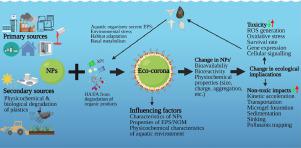Water Research ( IF 12.8 ) Pub Date : 2021-06-02 , DOI: 10.1016/j.watres.2021.117319 Muhammad Junaid 1 , Jun Wang 2

|
Nanoplastics (NPs) are plastic particles with sizes ranging between 1 and 1000 nm, exhibiting exceptional qualities such as large surface area, lightweight, durability; therefore, are widely used in cosmetics, paints, electronics, etc. NPs are inevitability released into the aquatic environment where they tend to interact with both, the extracellular polymeric substances (EPS) and other fractions of natural organic matter (NOM), respectively secreted by organisms (e.g., DNA, proteins, and carbohydrates) and degradation byproducts of organic materials (e.g., humic acid and fulvic acid) fluxed into the water bodies. These biomolecules robustly encapsulate NPs to develop an eco-corona layer that alters not only the physicochemical properties but also the fate, bioreactivity, and ecological impacts of NPs. Therefore, this review summarized the documented studies highlighting the eco-corona formation on NPs and associated ecological implications in the aquatic environment. After presenting the precise background information on the occurrence of NPs and EPS in the aquatic environment, we demonstrated the basic difference between eco-corona and bio-corona formation. The reviewed studies showed that the eco-corona formed on NPs have varying sizes and composition, mainly depending on the properties of parent biomolecules, characteristics of NPs, and physicochemical parameters of the aquatic environment. Further, the potential methods for characterization and quantification of eco-corona and its composition have been also highlighted. Moreover, the ecological implications (both toxic and non-toxic) of eco-corona formation on NPs in marine and freshwater environments have been also summarized. Last but not the least, challenges and future research directions are also given, e.g., conducting field studies on eco-corona formation in the aquatic environment, optimizing methods for its characterization and quantification, and considering eco-corona concept in the future toxicity studies on NPs. Finally, understanding eco-corona formation will be critical to unveil the complex NP interactions occurring in natural aquatic systems.
中文翻译:

纳米塑料与水生环境中细胞外聚合物 (EPS) 的相互作用:对生态电晕形成和相关影响的特别参考
纳米塑料 (NPs) 是尺寸在 1 到 1000 nm 之间的塑料颗粒,具有表面积大、重量轻、耐用等卓越品质;因此,被广泛用于化妆品、油漆、电子产品等。 NPs 不可避免地会释放到水生环境中,在那里它们往往会与细胞外聚合物 (EPS) 和天然有机物 (NOM) 的其他部分相互作用,分别分泌由生物体(例如 DNA、蛋白质和碳水化合物)和流入水体的有机物质(例如腐殖酸和富里酸)的降解副产物引起。这些生物分子牢固地包裹着 NPs,形成一个生态电晕层,不仅改变了 NPs 的理化特性,而且还改变了它们的命运、生物反应性和生态影响。所以,本综述总结了文献研究,强调了 NPs 的生态电晕形成和水生环境中的相关生态影响。在介绍了水生环境中 NPs 和 EPS 发生的精确背景信息后,我们证明了生态电晕和生物电晕形成之间的基本区别。回顾性研究表明,在纳米颗粒上形成的生态冠具有不同的大小和组成,主要取决于母体生物分子的性质、纳米颗粒的特性和水生环境的理化参数。此外,还强调了表征和量化生态电晕及其组成的潜在方法。而且,还总结了生态电晕形成对海洋和淡水环境中 NPs 的生态影响(有毒和无毒)。最后但同样重要的是,还给出了挑战和未来的研究方向,例如对水生环境中的生态电晕形成进行实地研究,优化其表征和量化方法,并在未来的毒性研究中考虑生态电晕概念。 NP。最后,了解生态电晕的形成对于揭示自然水生系统中发生的复杂 NP 相互作用至关重要。并在未来对纳米颗粒的毒性研究中考虑生态电晕概念。最后,了解生态电晕的形成对于揭示自然水生系统中发生的复杂 NP 相互作用至关重要。并在未来对纳米颗粒的毒性研究中考虑生态电晕概念。最后,了解生态电晕的形成对于揭示自然水生系统中发生的复杂 NP 相互作用至关重要。



























 京公网安备 11010802027423号
京公网安备 11010802027423号